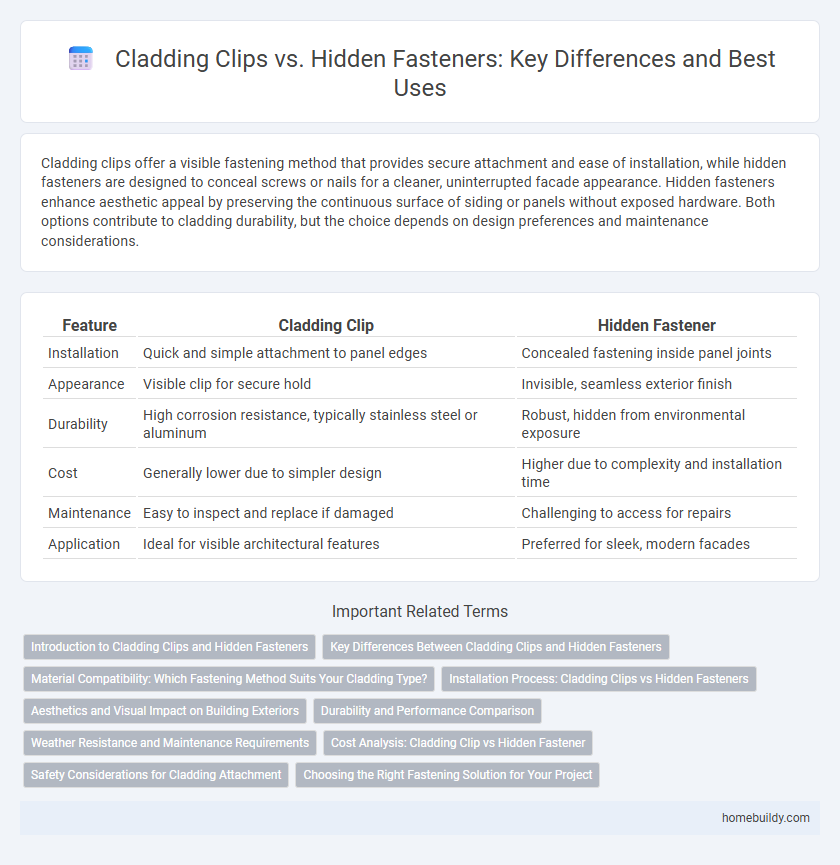Cladding clips offer a visible fastening method that provides secure attachment and ease of installation, while hidden fasteners are designed to conceal screws or nails for a cleaner, uninterrupted facade appearance. Hidden fasteners enhance aesthetic appeal by preserving the continuous surface of siding or panels without exposed hardware. Both options contribute to cladding durability, but the choice depends on design preferences and maintenance considerations.
Table of Comparison
| Feature | Cladding Clip | Hidden Fastener |
|---|---|---|
| Installation | Quick and simple attachment to panel edges | Concealed fastening inside panel joints |
| Appearance | Visible clip for secure hold | Invisible, seamless exterior finish |
| Durability | High corrosion resistance, typically stainless steel or aluminum | Robust, hidden from environmental exposure |
| Cost | Generally lower due to simpler design | Higher due to complexity and installation time |
| Maintenance | Easy to inspect and replace if damaged | Challenging to access for repairs |
| Application | Ideal for visible architectural features | Preferred for sleek, modern facades |
Introduction to Cladding Clips and Hidden Fasteners
Cladding clips provide a secure yet concealed method for attaching panels, enhancing aesthetic appeal by eliminating visible fixings. Hidden fasteners, designed for seamless integration, enable clean facade finishes while maintaining durability and ease of installation. Both systems improve weather resistance and structural stability in exterior cladding applications.
Key Differences Between Cladding Clips and Hidden Fasteners
Cladding clips are surface-mounted components that provide secure attachment points while remaining visible, facilitating easier installation and inspection. Hidden fasteners, on the other hand, are concealed beneath cladding panels, creating a seamless facade that enhances aesthetic appeal but can complicate maintenance. The key differences lie in visibility, installation complexity, and impact on the building's exterior appearance.
Material Compatibility: Which Fastening Method Suits Your Cladding Type?
Cladding clips are often made from corrosion-resistant materials like stainless steel or aluminum, ensuring compatibility with metal, wood, and composite cladding types without damaging the surface. Hidden fasteners, typically designed for specific materials such as wood or composite decking, offer a sleek aesthetic but may require material-specific variants to prevent corrosion or structural issues. Selecting the right fastening method depends on the cladding material's properties, environmental exposure, and durability requirements to ensure long-lasting performance.
Installation Process: Cladding Clips vs Hidden Fasteners
Cladding clips offer a simplified installation process by snapping directly onto the facade panels, reducing labor time and minimizing tool requirements compared to hidden fasteners. Hidden fasteners demand precise alignment and additional mechanical fixing steps, often requiring pre-drilled holes and specialized tools for secure attachment. The efficiency of cladding clips enhances project timelines, especially in large-scale exterior wall systems where speed and ease of installation are critical.
Aesthetics and Visual Impact on Building Exteriors
Cladding clips provide a sleek, low-profile attachment method that enhances the clean, minimalist aesthetic of building exteriors by eliminating visible screws or fasteners. Hidden fasteners, integrated behind panels, maintain uninterrupted facade surfaces and ensure a uniform visual appeal free from unsightly hardware. Both solutions improve the overall visual impact, but hidden fasteners offer superior concealment, making them ideal for modern architectural designs prioritizing seamless appearances.
Durability and Performance Comparison
Cladding clips offer superior durability by minimizing direct exposure to weather elements, reducing corrosion and extending the lifespan of exterior panels compared to hidden fasteners that rely on mechanical grip and may loosen over time. Performance-wise, cladding clips provide consistent panel alignment and allow for thermal expansion, preserving structural integrity under varying environmental conditions. Hidden fasteners can achieve a sleek aesthetic but often require more maintenance due to increased susceptibility to water infiltration and material fatigue.
Weather Resistance and Maintenance Requirements
Cladding clips provide superior weather resistance by creating a secure, ventilated barrier that prevents water infiltration and reduces moisture buildup compared to hidden fasteners, which may allow water to seep through fastener points. Maintenance requirements for cladding clips are generally lower as their exposed design facilitates easy inspection and replacement, whereas hidden fasteners often require more extensive removal of panels for upkeep. Choosing cladding clips enhances long-term durability and minimizes repair costs in harsh weather conditions.
Cost Analysis: Cladding Clip vs Hidden Fastener
Cladding clips typically offer a more cost-effective solution compared to hidden fasteners due to lower material and installation expenses. Hidden fasteners often require specialized tools and skilled labor, increasing overall project costs. Evaluating long-term durability and maintenance can also influence the total cost-effectiveness between cladding clips and hidden fasteners.
Safety Considerations for Cladding Attachment
Cladding clips offer enhanced safety by providing secure, concealed fastening that reduces the risk of panel detachment during extreme weather conditions. Hidden fasteners, while aesthetically pleasing, may present challenges in load distribution and require precise installation to prevent failures. Choosing the appropriate cladding attachment system depends on structural requirements, material compatibility, and adherence to building safety codes.
Choosing the Right Fastening Solution for Your Project
Cladding clips offer a streamlined appearance by securely attaching panels without visible screws, enhancing aesthetic appeal and weather resistance. Hidden fasteners provide strong support for heavier materials and complex designs, ensuring durability and ease of maintenance. Selecting the right fastening solution depends on project requirements, panel type, and desired finish, balancing visual impact with structural performance.
Cladding clip vs Hidden fastener Infographic

 homebuildy.com
homebuildy.com